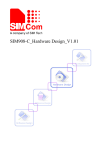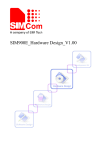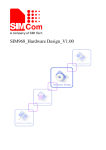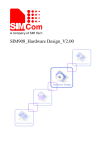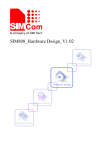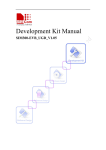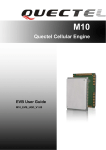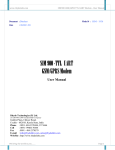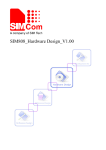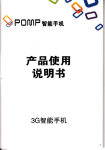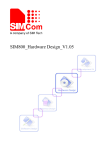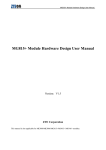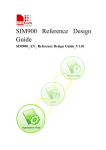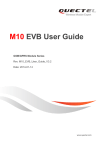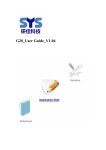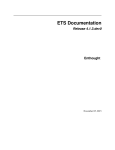Download SIM900_Hardware Design_V2.00
Transcript
SIM900_Hardware Design_V2.00 Smart Machine Smart Decision Document Title SIM900 Hardware Design Version 2.00 Date 2010-12-15 Status Release Document Control ID SIM900_Hardware Design_V2.00 General Notes SIMCom offers this information as a service to its customers, to support application and engineering efforts that use the products designed by SIMCom. The information provided is based upon requirements specifically provided to SIMCom by the customers. SIMCom has not undertaken any independent search for additional relevant information, including any information that may be in the customer’s possession. Furthermore, system validation of this product designed by SIMCom within a larger electronic system remains the responsibility of the customer or the customer’s system integrator. All specifications supplied herein are subject to change. Copyright This document contains proprietary technical information which is the property of SIMCom Limited, copying of this document and giving it to others and the using or communication of the contents thereof, are forbidden without express authority. Offenders are liable to the payment of damages. All rights reserved in the event of grant of a patent or the registration of a utility model or design. All specification supplied herein are subject to change without notice at any time. Copyright © Shanghai SIMCom Wireless Solutions Ltd. 2010 SIM900_Hardware Design_V2.00 2 2010-12-15 Smart Machine Smart Decision Contents Contents.................................................................................................................................................................... 3 Version History ........................................................................................................................................................ 7 1 Introduction....................................................................................................................................................... 8 2 SIM900 Overview ............................................................................................................................................. 8 2.1 SIM900 Key Features............................................................................................................................... 8 2.2 Operating Modes .................................................................................................................................... 10 2.3 SIM900 Functional Diagram ...................................................................................................................11 3 Package Information ...................................................................................................................................... 12 3.1 Pin out Diagram...................................................................................................................................... 12 3.2 Pin Description ....................................................................................................................................... 13 3.3 Package Dimensions............................................................................................................................... 15 4 Application Interface...................................................................................................................................... 16 4.1 Power Supply.......................................................................................................................................... 16 4.1.1 Minimizing Voltage Drop of VBAT ................................................................................................... 17 4.1.2 Monitoring Power Supply ................................................................................................................... 17 4.2 Power on/down Scenarios ...................................................................................................................... 17 4.2.1 Power on SIM900 ............................................................................................................................... 17 4.2.2 Power down SIM900........................................................................................................................... 18 4.2.3 Restart SIM900 by PWRKEY Pin ...................................................................................................... 20 4.3 Power Saving Mode................................................................................................................................ 20 4.3.1 Minimum Functionality Mode ............................................................................................................ 20 4.3.2 Sleep Mode 1 (AT+CSCLK=1) .......................................................................................................... 21 4.3.3 Wake Up SIM900 from Sleep Mode 1 (AT+CSCLK=1) ................................................................... 21 4.3.4 Sleep Mode 2 (AT+CSCLK=2) .......................................................................................................... 21 4.3.5 Wake Up SIM900 from Sleep Mode 2 (AT+CSCLK=2) ................................................................... 22 4.4 RTC Backup ........................................................................................................................................... 22 4.5 Serial Interfaces ...................................................................................................................................... 23 4.5.1 Function of Serial Port and Debug Port .............................................................................................. 24 4.5.2 Software Upgrade and Debug ............................................................................................................. 25 4.6 Audio Interfaces ..................................................................................................................................... 25 4.6.1 Speaker Interface Configuration ......................................................................................................... 25 4.6.2 Microphone Interfaces Configuration ................................................................................................. 26 4.6.3 Earphone Interface Configuration....................................................................................................... 27 4.6.4 Audio Electronic Characteristics......................................................................................................... 27 4.7 SIM Card Interface ................................................................................................................................. 28 4.7.1 SIM Card Application ......................................................................................................................... 28 4.7.2 Design Considerations for SIM Card Holder ...................................................................................... 29 4.8 LCD Display/SPI Interface..................................................................................................................... 30 4.9 Keypad Interface .................................................................................................................................... 31 4.10 ADC........................................................................................................................................................ 32 4.11 RI Behaviors........................................................................................................................................... 32 4.12 Network Status Indication ...................................................................................................................... 33 SIM900_Hardware Design_V2.00 3 2010-12-15 Smart Machine Smart Decision 4.13 4.14 4.15 4.16 4.17 General Purpose Input/Output (GPIO) ................................................................................................... 34 External Reset......................................................................................................................................... 34 PWM ...................................................................................................................................................... 35 I2C Bus.................................................................................................................................................... 35 Antenna Interface ................................................................................................................................... 35 5 Electrical, Reliability and Radio Characteristics......................................................................................... 37 5.1 Absolute Maximum Ratings................................................................................................................... 37 5.2 Recommended Operating Conditions..................................................................................................... 37 5.3 Digital Interface Characteristics ............................................................................................................. 37 5.4 SIM Card Interface Characteristics ........................................................................................................ 37 5.5 VDD_EXT Characteristics ..................................................................................................................... 38 5.6 SIM_VDD Characteristics...................................................................................................................... 38 5.7 VRTC Characteristics ............................................................................................................................. 38 5.8 Current Consumption (VBAT = 3.8V) ................................................................................................... 39 5.9 Electro-Static Discharge ......................................................................................................................... 40 5.10 Radio Characteristics.............................................................................................................................. 40 5.10.1 Module RF Output Power................................................................................................................ 40 5.10.2 Module RF Receive Sensitivity ....................................................................................................... 41 5.10.3 Module Operating Frequencies........................................................................................................ 42 6 Manufacturing ................................................................................................................................................ 43 6.1 Top and Bottom View of SIM900 .......................................................................................................... 43 6.2 Typical Solder Reflow Profile................................................................................................................ 43 6.3 Moisture Sensitivity Level (MSL).......................................................................................................... 43 Appendix ................................................................................................................................................................ 44 A. Related Documents.......................................................................................................................................... 44 B. Terms and Abbreviations ................................................................................................................................. 45 C. Safety Caution ................................................................................................................................................. 46 SIM900_Hardware Design_V2.00 4 2010-12-15 Smart Machine Smart Decision Table Index TABLE 1: SIM900 KEY FEATURES................................................................................................................................ 8 TABLE 2: CODING SCHEMES AND MAXIMUM NET DATA RATES OVER AIR INTERFACE ............................ 10 TABLE 3: OVERVIEW OF OPERATING MODES........................................................................................................ 10 TABLE 4: PIN DESCRIPTION ....................................................................................................................................... 13 TABLE 5: THE CURRENT CONSUMPTION OF MINIMUM FUNCTIONALITY MODE ........................................ 21 TABLE 6: MICROPHONE INPUT CHARACTERISTICS ............................................................................................ 27 TABLE 7: AUDIO OUTPUT CHARACTERISTICS ...................................................................................................... 28 TABLE 8: PIN DESCRIPTION (AMPHENOL SIM CARD HOLDER)......................................................................... 29 TABLE 9: PIN DESCRIPTION (MOLEX SIM CARD HOLDER) ................................................................................ 30 TABLE 10: PIN DEFINITION OF THE KEYPAD INTERFACE................................................................................... 31 TABLE 11: ADC SPECIFICATION................................................................................................................................. 32 TABLE 12: RI BEHAVIORS ........................................................................................................................................... 32 TABLE 13: STATUS OF THE NETLIGHT PIN.............................................................................................................. 33 TABLE 14: PIN DEFINITION OF THE GPIO INTERFACE ......................................................................................... 34 TABLE 15: ABSOLUTE MAXIMUM RATINGS........................................................................................................... 37 TABLE 16: RECOMMENDED OPERATING CONDITIONS ....................................................................................... 37 TABLE 17: DIGITAL INTERFACE CHARACTERISTICS ........................................................................................... 37 TABLE 18: SIM CARD INTERFACE CHARACTERISTICS........................................................................................ 38 TABLE 19: VDD_EXT CHARACTERISTICS ............................................................................................................... 38 TABLE 20: SIM_VDD CHARACTERISTICS................................................................................................................ 38 TABLE 21: VRTC CHARACTERISTICS ....................................................................................................................... 38 TABLE 22: CURRENT CONSUMPTION ...................................................................................................................... 39 TABLE 23: THE ESD CHARACTERISTICS (TEMPERATURE: 25℃, HUMIDITY: 45 %) ....................................... 40 TABLE 24: SIM900 GSM 900 AND GSM 850 CONDUCTED RF OUTPUT POWER ................................................ 40 TABLE 25: SIM900 DCS 1800 AND PCS 1900 CONDUCTED RF OUTPUT POWER............................................... 41 TABLE 26: SIM900 CONDUCTED RF RECEIVE SENSITIVITY ............................................................................... 42 TABLE 27: SIM900 OPERATING FREQUENCIES....................................................................................................... 42 TABLE 28: RELATED DOCUMENTS ........................................................................................................................... 44 TABLE 29: TERMS AND ABBREVIATIONS................................................................................................................ 45 TABLE 30: SAFETY CAUTION..................................................................................................................................... 46 SIM900_Hardware Design_V2.00 5 2010-12-15 Smart Machine Smart Decision Figure Index FIGURE 1: SIM900 FUNCTIONAL DIAGRAM ........................................................................................................... 11 FIGURE 2: SIM900 PIN OUT DIAGRAM (TOP VIEW) ............................................................................................... 12 FIGURE 3: DIMENSIONS OF SIM900(UNIT: MM)................................................................................................ 15 FIGURE 4: RECOMMENDED PCB FOOTPRINT OUTLINE(UNIT: MM)............................................................ 15 FIGURE 5: REFERENCE CIRCUIT OF THE LDO POWER SUPPLY ......................................................................... 16 FIGURE 6: REFERENCE CIRCUIT OF THE DC-DC POWER SUPPLY..................................................................... 16 FIGURE 7: VBAT VOLTAGE DROP DURING TRANSMIT BURST........................................................................... 17 FIGURE 8: THE MINIMAL VBAT VOLTAGE REQUIREMENT AT VBAT DROP .................................................... 17 FIGURE 9: POWERED ON/DOWN MODULE USING TRANSISTOR....................................................................... 17 FIGURE 10: POWERED ON/DOWN MODULE USING BUTTON ............................................................................. 18 FIGURE 11: TIMING OF POWER ON MODULE......................................................................................................... 18 FIGURE 12: TIMING OF POWER DOWN SIM900 BY PWRKEY .............................................................................. 19 FIGURE 13: TIMING OF RESTART SIM900 ................................................................................................................ 20 FIGURE 14: RTC SUPPLY FROM CAPACITOR........................................................................................................... 22 FIGURE 15: RTC SUPPLY FROM NON-CHARGEABLE BATTERY ......................................................................... 22 FIGURE 16: RTC SUPPLY FROM RECHARGEABLE BATTERY .............................................................................. 22 FIGURE 17: SEIKO XH414H-IV01E CHARGE-DISCHARGE CHARACTERISTIC ................................................. 23 FIGURE 18: CONNECTION OF THE SERIAL INTERFACES..................................................................................... 23 FIGURE 19: CONNECTION OF RXD AND TXD ONLY ............................................................................................. 24 FIGURE 20: CONNECTION FOR SOFTWARE UPGRADING AND DEBUGGING.................................................. 25 FIGURE 21: SPEAKER REFERENCE CIRCUIT .......................................................................................................... 25 FIGURE 22: SPEAKER WITH AMPLIFIER REFERENCE CIRCUIT ......................................................................... 26 FIGURE 23 : MICROPHONE REFERENCE CIRCUIT................................................................................................. 26 FIGURE 24: EARPHONE REFERENCE CIRCUIT ....................................................................................................... 27 FIGURE 25: REFERENCE CIRCUIT OF THE 8-PIN SIM CARD HOLDER............................................................... 28 FIGURE 26: REFERENCE CIRCUIT OF THE 6-PIN SIM CARD HOLDER............................................................... 29 FIGURE 27: AMPHENOL C707 10M006 5122 SIM CARD HOLDER......................................................................... 29 FIGURE 28: MOLEX 91228 SIM CARD HOLDER ...................................................................................................... 30 FIGURE 29: REFERENCE CIRCUIT OF THE KEYPAD INTERFACE ....................................................................... 31 FIGURE 30: RI BEHAVIOUR OF VOICE CALLING AS A RECEIVER...................................................................... 32 FIGURE 31: RI BEHAVIOUR OF DATA CALLING AS A RECEIVER........................................................................ 33 FIGURE 32: RI BEHAVIOUR OF URC OR RECEIVE SMS ........................................................................................ 33 FIGURE 33: RI BEHAVIOUR AS A CALLER ............................................................................................................... 33 FIGURE 34: REFERENCE CIRCUIT OF NETLIGHT .................................................................................................. 34 FIGURE 35: RESET TIMING ......................................................................................................................................... 35 FIGURE 36: RESET REFERENCE DESIGN CIRCUIT ................................................................................................ 35 FIGURE 37: ANTENNA MATCHING CIRCUIT ........................................................................................................... 36 FIGURE 38: TOP AND BOTTOM VIEW OF SIM900 ................................................................................................... 43 FIGURE 39: TYPICAL SOLDER REFLOW PROFILE ................................................................................................. 43 SIM900_Hardware Design_V2.00 6 2010-12-15 Smart Machine Smart Decision Version History Date Version Description of change Author 2009-12-26 1.01 Origin LiGang 2010-02-04 1.02 Modify the voltage range of ADC input. Modify the figure of bottom mechanical dimensions of module. Modify the figure of recommended PCB decal and the note. LiGang 2010-04-07 1.03 §2, § 2.1 Changed the lowest current consumption in sleep mode from 1.5mA to 1.0mA. §3.1 Add the description of the RXD pin, this pin should be pulled up to VDD_EXT. §3.4.2.1 Change the pull down time of the figure 12. Change the impulse time of the figure 13. §3.8.1 Update the description of autobauding. The default setting is autobauding mode. LiGang §3.9.4 Add audio parameters in table 10 and table 11. §3.10.1 Change the value of the capacitance from 220nF to 100nF in figure 27 and figure 28. §3.13 Delete the pull up resistor of figure 32. 2010-05-07 1.04 §2.1, § 3.4.2.3 Modify the power supply range from 3.4V~4.5V to 3.2V~4.8V. LiGang 2010-06-23 1.05 §3.7, Modify the VRTC pin connection when backup is not needed. §3.4, Revise Figure 8 & Figure 11 §5.3 Revise the Supply Voltage Range ZhouQiang Modify the power supply range to 3.2V~4.8V. §3.4 Modified figure 7, figure8, figure15. §3.4 Add table 7. §3.5 Add 3.5.4 and 3.5.5 description. Delete chapter 3.6. §3.11 Modified the keypad from 5x5 to 4x5. ADD figure 32, figure 33, figure 34, figure 38. §6.2 Modified figure 42 LiGang 2010-07-16 1.06 2010-10-26 1.07 §6.1 Modified Figure 2: Recommended PCB decal. LiGang 2010.12.15 2.00 Arrange the structure of document. LiGang SIM900_Hardware Design_V2.00 7 2010.12.15 Smart Machine Smart Decision 1 Introduction This document describes SIM900 hardware interface in great detail. This document can help user to quickly understand SIM900 interface specifications, electrical and mechanical details. With the help of this document and other SIM900 application notes, user guide, users can use SIM900 to design various applications quickly. 2 SIM900 Overview Designed for global market, SIM900 is a quad-band GSM/GPRS module that works on frequencies GSM 850MHz, EGSM 900MHz, DCS 1800MHz and PCS 1900MHz. SIM900 features GPRS multi-slot class 10/ class 8 (optional) and supports the GPRS coding schemes CS-1, CS-2, CS-3 and CS-4. With a tiny configuration of 24*24*3mm, SIM900 can meet almost all the space requirements in user applications, such as M2M, smart phone, PDA and other mobile devices. SIM900 has 68 SMT pads, and provides all hardware interfaces between the module and customers’ boards. z z z z Serial port and debug port can help user easily develop user’s applications. Audio channel which includes a microphone input and a receiver output. Programmable general purpose input and output. The keypad and SPI display interfaces will give users the flexibility to develop customized applications. SIM900 is designed with power saving technique so that the current consumption is as low as 1.0mA in sleep mode. SIM900 integrates TCP/IP protocol and extended TCP/IP AT commands which are very useful for data transfer applications. For details about TCP/IP applications, please refer to document [2]. 2.1 SIM900 Key Features Table 1: SIM900 key features Feature Implementation Power supply 3.2V ~ 4.8V Power saving Typical power consumption in sleep mode is 1.0mA ( BS-PA-MFRMS=9 ) z z SIM900 Quad-band: GSM 850, EGSM 900, DCS 1800, PCS 1900. SIM900 can search the 4 frequency bands automatically. The frequency bands also can be set by AT command “AT+CBAND”. For details, please refer to document [1]. Compliant to GSM Phase 2/2+ Transmitting power z z Class 4 (2W) at GSM 850 and EGSM 900 Class 1 (1W) at DCS 1800 and PCS 1900 GPRS connectivity z GPRS multi-slot class 10(default) Frequency bands SIM900_Hardware Design_V2.00 8 2010-12-15 Smart Machine Smart Decision z GPRS multi-slot class 8 (option) Temperature range z z z Normal operation: -30°C ~ +80°C Restricted operation: -40°C ~ -30°C and +80 °C ~ +85°C* Storage temperature -45°C ~ +90°C Data GPRS z z z z z GPRS data downlink transfer: max. 85.6 kbps GPRS data uplink transfer: max. 42.8 kbps Coding scheme: CS-1, CS-2, CS-3 and CS-4 Integrate the TCP/IP protocol. Support Packet Broadcast Control Channel (PBCCH) CSD z Support CSD transmission USSD z Unstructured Supplementary Services Data (USSD) support SMS z z MT, MO, CB, Text and PDU mode SMS storage: SIM card FAX Group 3 Class 1 SIM interface Support SIM card: 1.8V, 3V External antenna Antenna pad Audio features Speech codec modes: z Half Rate (ETS 06.20) z Full Rate (ETS 06.10) z Enhanced Full Rate (ETS 06.50 / 06.60 / 06.80) z Adaptive multi rate (AMR) z Echo Cancellation z Noise Suppression z Serial port and debug port z z z z z z z * Serial port: Full modem interface with status and control lines, unbalanced, asynchronous. 1200bps to 115200bps. Can be used for AT commands or data stream. Support RTS/CTS hardware handshake and software ON/OFF flow control. Multiplex ability according to GSM 07.10 Multiplexer Protocol. Autobauding supports baud rate from 1200 bps to 57600bps. Debug port: Null modem interface DBG_TXD and DBG_RXD. Can be used for debugging and upgrading firmware. Phonebook management Support phonebook types: SM, FD, LD, RC, ON, MC. SIM application toolkit GSM 11.14 Release 99 Real time clock Support RTC Physical characteristics Size: 24*24*3mm Weight: 3.4g Firmware upgrade Firmware upgradeable by debug port. SIM900 does work at this temperature, but some radio frequency characteristics may deviate from the GSM specification. SIM900_Hardware Design_V2.00 9 2010-12-15 Smart Machine Smart Decision Table 2: Coding schemes and maximum net data rates over air interface Coding scheme 1 timeslot 2 timeslot 4 timeslot CS-1 9.05kbps 18.1kbps 36.2kbps CS-2 13.4kbps 26.8kbps 53.6kbps CS-3 15.6kbps 31.2kbps 62.4kbps CS-4 21.4kbps 42.8kbps 85.6kbps 2.2 Operating Modes The table below summarizes the various operating modes of SIM900. Table 3: Overview of operating modes Mode Normal operation Function GSM/GPRS SLEEP Module will automatically go into sleep mode if the conditions of sleep mode are enabling and there is no on air and no hardware interrupt (such as GPIO interrupt or data on serial port). In this case, the current consumption of module will reduce to the minimal level. In sleep mode, the module can still receive paging message and SMS. GSM IDLE Software is active. Module registered to the GSM network, and the module is ready to communicate. GSM TALK Connection between two subscribers is in progress. In this case, the power consumption depends on network settings such as DTX off/on, FR/EFR/HR, hopping sequences, antenna. GPRS STANDBY Module is ready for GPRS data transfer, but no data is currently sent or received. In this case, power consumption depends on network settings and GPRS configuration. GPRS DATA There is GPRS data transfer (PPP or TCP or UDP) in progress. In this case, power consumption is related with network settings (e.g. power control level); uplink/downlink data rates and GPRS configuration (e.g. used multi-slot settings). Power down Normal power down by sending the AT command “AT+CPOWD=1” or using the PWRKEY. The power management unit shuts down the power supply for the baseband part of the module, and only the power supply for the RTC is remained. Software is not active. The serial port is not accessible. Power supply (connected to VBAT) remains applied. Minimum functionality mode AT command “AT+CFUN” can be used to set the module to a minimum functionality mode without removing the power supply. In this mode, the RF part of the module will not work or the SIM card will not be accessible, or both RF part and SIM card will be closed, and the serial port is still accessible. The power consumption in this mode is lower than normal mode. SIM900_Hardware Design_V2.00 10 2010-12-15 Smart Machine Smart Decision 2.3 SIM900 Functional Diagram The following figure shows a functional diagram of SIM900: z The GSM baseband engine z Flash z The GSM radio frequency part z The antenna interface z The other interfaces Figure 1: SIM900 functional diagram SIM900_Hardware Design_V2.00 11 2010-12-15 Smart Machine Smart Decision GPIO12 GPIO11 STATUS GND GND GND GND GND RF_ANT GND GND VBAT VBAT VBAT GND GND NETLIGHT 68 67 66 65 64 63 62 61 60 59 58 57 56 55 54 53 52 Pin out Diagram PWRKEY 1 51 GPIO10 NC 2 50 GPIO9/KBC1 DTR 3 49 GPIO8/KBC2 RI 4 48 GPIO7/KBC3 DCD 5 47 GPIO6/KBC4 NC 6 46 GND CTS 7 45 GND RTS 8 44 GPIO5/KBR0 TXD 9 43 GPIO4/KBR1 RXD 10 42 GPIO3/KBR2 DISP_CLK 11 41 GPIO2/KBR3 DISP_DATA 12 40 GPIO1/KBR4 DISP_D/C 13 39 GND DISP_CS 14 38 SCL VDD_EXT 15 37 SDA NRESET 16 36 PWM2 GND 17 35 PWM1 33 34 28 SIM_RST 27 DBG_TXD DBG_RXD SIM_PRESENCE 26 32 25 ADC VRTC 31 24 LINEIN_L SIM_CLK 23 SIM_DATA 22 SPK_N LINEIN_R 30 21 29 20 MIC_N SPK_P GND 19 SIM_VDD 18 SIM900 TOP VIEW GND 3.1 Package Information MIC_P 3 Figure 2: SIM900 pin out diagram (Top view) SIM900_Hardware Design_V2.00 12 2010-12-15 Smart Machine Smart Decision 3.2 Pin Description Table 4: Pin description Pin name Pin number I/O Description 55,56,57 I Power supply Comment Power supply VBAT VRTC 26 I/O Power supply for RTC It is recommended to connect with a battery or a capacitor (e.g. 4.7uF). VDD_EXT 15 O 2.8V output power supply If it is unused, keep open. GND 17,18,29,39, 45,46,53,54, 58,59,61,62, 63,64,65 Ground Power on/down PWRKEY 1 I PWRKEY should be pulled low at least 1 second and then released to power on/down the module. I Differential audio input O Differential audio output I Line-in input Pulled up internally. Audio interfaces MIC_P 19 MIC_N 20 SPK_P 21 SPK_N 22 LINEIN_R 23 LINEIN_L 24 If these pins are unused, keep open. Status STATUS 66 O Power on status NETLIGHT 52 O Network status DISP _CLK 11 O DISP_DATA 12 I/O DISP _D/C 13 O DISP _CS 14 O 37 O If these pins are unused, keep open. LCD interface Display interface If these pins are unused, keep open. 2 I C interface SDA SCL 38 I2C serial bus data 2 I/O I C serial bus clock I/O GPIO5/keypad row 0 If these pins are unused, keep open. Keypad interface / GPIOs GPIO5/KBR0 44 GPIO4/KBR1 43 GPIO4/keypad row 1 GPIO3/KBR2 42 GPIO3/keypad row 2 GPIO2/KBR3 41 GPIO2/keypad row 3 SIM900_Hardware Design_V2.00 13 If these pins are unused, keep open. 2010-12-15 Smart Machine Smart Decision GPIO1/KBR4 40 GPIO1/keypad row 4 GPIO9/KBC1 50 GPIO9/keypad column 1 GPIO8/KBC2 49 GPIO8/keypad column 2 GPIO7/KBC3 48 GPIO7/keypad column 3 GPIO6/KBC4 47 GPIO6/keypad column 4 GPIO10 51 GPIO10 GPIO11 67 GPIO11 GPIO12 68 GPIO12 Serial port This pin should be pulled up to VDD_EXT externally. RXD 10 I Receive data TXD 9 O Transmit data RTS 8 I Request to send CTS 7 O Clear to send DCD 5 O Data carrier detect RI 4 O Ring indicator DTR 3 I Data terminal ready DBG_TXD 27 O DBG_RXD 28 I SIM_VDD 30 O Voltage supply for SIM card. Support 1.8V or 3V SIM card SIM_DATA 31 I/O SIM data input/output SIM_CLK 32 O SIM clock SIM_RST 33 O SIM reset SIM_PRESEN CE 34 I SIM card detection If it is unused, keep open. 25 I Input voltage range: 0V ~ 2.8V If it is unused, keep open. 16 I Reset input(Active low) Recommend connecting a 100nF capacitor. If these pins are unused, keep open. Debug interface For debugging and upgrading firmware If these pins are unused, keep open. SIM interface All signals of SIM interface should be protected against ESD with a TVS diode array. ADC ADC External reset NRESET Pulse width modulation( PWM ) PWM1 35 O PWM If these pins are unused, keep open. PWM2 36 O PWM 60 I/O Radio antenna connection 2,6 - RF interface RF_ANT Impendence must controlled to 50Ω. be Not connect NC SIM900_Hardware Design_V2.00 These pins should be kept open. 14 2010-12-15 Smart Machine Smart Decision 3.3 Package Dimensions BOTTOM VIEW TOP VIEW Figure 3: Dimensions of SIM900(Unit: mm) Figure 4: Recommended PCB footprint outline(Unit: mm) Note: Keep copper out of area A. Do not place via in area B to avoid short circuit between the via on customer board and the test points on the bottom side of the module. SIM900_Hardware Design_V2.00 15 2010-12-15 Smart Machine Smart Decision 4 4.1 Application Interface Power Supply GND The power supply range of SIM900 is from 3.2V to 4.8V. The transmitting burst will cause voltage drop and the power supply must be able to provide sufficient current up to 2A. For the VBAT input, a bypass capacitor (low ESR) such as a 100 µF is strongly recommended; this capacitor should be placed as close as possible to SIM900 VBAT pins. The following figure is the reference design of +5V input power supply. The designed output for the power supply is 4.1V, thus a linear regulator can be used. Figure 5: Reference circuit of the LDO power supply If there is a high drop-out between the input and the desired output (VBAT), a DC-DC power supply will be preferable because of its better efficiency especially with the 2A peak current in burst mode of the module. The following figure is the reference circuit. Figure 6: Reference circuit of the DC-DC power supply The single 3.6V Li-ion cell battery can be connected to SIM900 VBAT pins directly. But the Ni-Cd or Ni-MH battery must be used carefully, since their maximum voltage can rise over the absolute maximum voltage of the module and damage it. When battery is used, the total impedance between battery and VBAT pins should be less than 150mΩ. The following figure shows the VBAT voltage drop at the maximum power transmit phase, and the test condition is as following: VBAT=4.0V, A VBAT bypass capacitor CA=100µF tantalum capacitor (ESR=0.7Ω), Another VBAT bypass capacitor CB=1µF. SIM900_Hardware Design_V2.00 16 2010-12-15 Smart Machine Smart Decision Figure 7: VBAT voltage drop during transmit burst 4.1.1 Minimizing Voltage Drop of VBAT When designing the power supply in user’s application, pay special attention to power losses. Ensure that the input voltage never drops below 3.1V even when current consumption rises to 2A in the transmit burst. If the power voltage drops below 3.1V, the module may be shut down automatically. The PCB traces from the VBAT pins to the power supply must be wide enough (at least 60mil) to decrease voltage drops in the transmit burst. The power IC and the bypass capacitor should be placed to the module as close as possible. Figure 8: The minimal VBAT voltage requirement at VBAT drop 4.1.2 Monitoring Power Supply The AT command “AT+CBC” can be used to monitor the VBAT voltage. For detail, please refer to document [1]. 4.2 4.2.1 Power on/down Scenarios Power on SIM900 User can power on SIM900 by pulling down the PWRKEY pin for at least 1 second and release. This pin is already pulled up to 3V in the module internal, so external pull up is not necessary. Reference circuit is shown as below. Figure 9: Powered on/down module using transistor SIM900_Hardware Design_V2.00 17 2010-12-15 Smart Machine Smart Decision Figure 10: Powered on/down module using button The power on scenarios is illustrated as following figure. Figure 11: Timing of power on module When power on procedure is completed, SIM900 will send following URC to indicate that the module is ready to operate at fixed baud rate. RDY This URC does not appear when autobauding function is active. Note: User can use AT command “AT+IPR=x” to set a fixed baud rate and save the configuration to non-volatile flash memory. After the configuration is saved as fixed baud rate, the Code “RDY” should be received from the serial port every time when SIM900 is powered on. For details, please refer to the chapter “AT+IPR” in document [1]. 4.2.2 Power down SIM900 SIM900 will be powered down in the following situations: z Normal power down procedure: power down SIM900 by the PWRKEY pin. z Normal power down procedure: power down SIM900 by AT command “AT+CPOWD=1”. z Abnormal power down: over-voltage or under-voltage automatic power down. z Abnormal power down: over-temperature or under-temperature automatic power down. 4.2.2.1 Power down SIM900 by the PWRKEY Pin User can power down SIM900 by pulling down the PWRKEY pin for at least 1 second and release. Please refer to the power on circuit. The power down scenario is illustrated in following figure. SIM900_Hardware Design_V2.00 18 2010-12-15 Smart Machine Smart Decision Figure 12: Timing of power down SIM900 by PWRKEY This procedure makes the module log off from the network and allows the software to enter into a secure state to save data before completely shut down. Before the completion of the power down procedure, the module will send URC: NORMAL POWER DOWN At this moment, AT commands can not be executed any more, and only the RTC is still active. Power down mode can also be indicated by STATUS pin, which is at low level at this time. 4.2.2.2 Power down SIM900 by AT Command SIM900 can be powered down by AT command “AT+CPOWD=1”. This procedure makes the module log off from the network and allows the software to enter into a secure state to save data before completely shut down. Before the completion of the power down procedure, the module will send URC: NORMAL POWER DOWN At this moment, AT commands can not be executed any more, and only the RTC is still active. Power down mode can also be indicated by STATUS pin, which is at low level at this time. For detail about the AT command “AT+CPOWD”, please refer to document [1] 4.2.2.3 Over-voltage or Under-voltage Power down The module software monitors the VBAT voltage constantly. If the voltage ≤ 3.3V, the following URC will be reported: UNDER-VOLTAGE WARNNING If the voltage ≥ 4.7V, the following URC will be reported: OVER-VOLTAGE WARNNING If the voltage < 3.2V, the following URC will be reported, and the module will be automatically powered down. UNDER-VOLTAGE POWER DOWN If the voltage > 4.8V, the following URC will be reported, and the module will be automatically powered down. OVER-VOLTAGE POWER DOWN At this moment, AT commands can not be executed any more, and only the RTC is still active. Power down mode can also be indicated by STATUS pin, which is at low level at this time. SIM900_Hardware Design_V2.00 19 2010-12-15 Smart Machine Smart Decision 4.2.2.4 Over-temperature or Under-temperature Power down The module will constantly monitor the temperature of the module, If the temperature > +80℃, the following URC will be reported: +CMTE: 1 If the temperature < -30℃, the following URC will be reported: +CMTE:-1 If the temperature > +85℃, the following URC will be reported, and the module will be automatically powered down. +CMTE: 2 If the temperature < -40℃, the following URC will be reported, and the module will be automatically powered down. +CMTE:-2 At this moment, AT commands can not be executed any more, and only the RTC is still active. Power down mode can also be indicated by STATUS pin, which is at low level at this time. The AT command “AT+CMTE” could be used to read the temperature when the module is running. For details please refer to document [1]. 4.2.3 Restart SIM900 by PWRKEY Pin When the module works normally, if the user wants to restart the module, follow the procedure below: 1) Power down the module. 2) Wait for at least 800mS after STATUS pin changed to low level. 3) Power on the module. Power down Delay > 800mS Restart PWRKEY STATUS Figure 13: Timing of restart SIM900 4.3 Power Saving Mode SIM900 have two sleep modes: sleep mode 1 is enabled by hardware pin DTR; sleep mode 2 is only enabled by serial port regardless of the DTR. In sleep mode, the current of module is very low. The AT command “AT+CFUN=<fun>” can be used to set SIM900 into minimum functionality. When SIM900 is in sleep mode and minimum functionality, the current of module is lowest. 4.3.1 Minimum Functionality Mode There are three functionality modes, which could be set by the AT command “AT+CFUN=<fun>”. The command provides the choice of the functionality levels <fun>=0,1,4. SIM900_Hardware Design_V2.00 20 2010-12-15 Smart Machine Smart Decision z 0: minimum functionality. z 1: full functionality (default). z 4: flight mode (disable RF function). Minimum functionality mode minimizes the current consumption to the lowest level. If SIM900 is set to minimum functionality by “AT+CFUN=0”, the RF function and SIM card function will be disabled. In this case, the serial port is still accessible, but all AT commands correlative with RF function and SIM card function will not be accessible. For detailed information about the AT Command “AT+CFUN=<fun>”, please refer to document [1]. Table 5: The Current consumption of Minimum Functionality Mode <fun> Current consumption(uA) (sleep mode) 0 651 1 1000 4 715 4.3.2 Sleep Mode 1 (AT+CSCLK=1) User can control SIM900 module to enter or exit the sleep mode 1 (AT+CSCLK=1) by DTR signal. When DTR is in high level and without interrupt (on air and hardware such as GPIO interrupt or data in serial port), SIM900 will enter sleep mode 1 automatically. In this mode, SIM900 can still receive paging or SMS from network but the serial port is not accessible. Note: For SIM900, it requests to set AT command “AT+CSCLK=1” and ensure DTR at high level to enable the sleep mode 1; the default value is 0, which can not make the module to enter sleep mode. For more details please refer to document [1]. 4.3.3 Wake Up SIM900 from Sleep Mode 1 (AT+CSCLK=1) When SIM900 is in sleep mode 1 (AT+CSCLK=1), the following methods can wake up the module: z Pull down DTR pin. The serial port will be active after DTR pin is pulled to low level for about 50ms. z Receive a voice or data call from network. z Receive a SMS from network. 4.3.4 Sleep Mode 2 (AT+CSCLK=2) In this mode, SIM900 will continuously monitor the serial port data signal. When there is no data transfer over 5 seconds on the RXD signal and there is no on air and hardware interrupts (such as GPIO interrupt), SIM900 will enter sleep mode 2 automatically. In this mode, SIM900 can still receive paging or SMS from network but the serial port is not accessible. Note: For SIM900, It is requested to set AT command “AT+CSCLK=2” to enable the sleep mode 2; the default value is 0, which can not make the module to enter sleep mode. For more details please refer to document [1]. SIM900_Hardware Design_V2.00 21 2010-12-15 Smart Machine Smart Decision 4.3.5 Wake Up SIM900 from Sleep Mode 2 (AT+CSCLK=2) When SIM900 is in sleep mode 2 (AT+CSCLK=2), the following methods can wake up the module: z Send data to SIM900 via main serial port. * z Receive a voice or data call from network. z Receive a SMS from network. * Note: The first byte of the user’s data will not be recognized. 4.4 RTC Backup Current input for RTC when the VBAT is not supplied for the system. Current output for backup battery when the VBAT power supply is in present and the backup battery is in low voltage state. The RTC power supply of module can be provided by an external capacitor or a battery (non-chargeable or rechargeable) through the VRTC. The following figures show various reference circuits for RTC back up. z External capacitor backup Figure 14: RTC supply from capacitor z Non-chargeable battery backup Figure 15: RTC supply from non-chargeable battery z Rechargeable battery backup Figure 16: RTC supply from rechargeable battery SIM900_Hardware Design_V2.00 22 2010-12-15 Smart Machine Smart Decision Coin-type rechargeable battery is recommended, such as XH414H-IV01E form Seiko can be used. Typical charge-discharge curves for this battery are shown in the following figure. Figure 17: Seiko XH414H-IV01E Charge-Discharge Characteristic 4.5 Serial Interfaces SIM900 provides two unbalanced asynchronous serial ports. One is the serial port and the other is the debug port. The module is designed as a DCE (Data Communication Equipment). The following figure shows the connection between module and client (DTE). MODULE (DCE) CUSTOMER (DTE) Serial port Serial port1 TXD TXD RXD RXD RTS RTS CTS CTS DTR DTR DCD DCD RI RING Debug port Serial port2 DBG_TX TXD DBG_RX RXD Figure 18: Connection of the serial interfaces If only RXD and TXD are used in user’s application, other serial pins should be kept open. Please refer to following figure. SIM900_Hardware Design_V2.00 23 2010-12-15 Smart Machine Smart Decision MODULE (DCE) CUSTOMER (DTE) Serial port Serial port1 TXD TXD RXD RXD RTS RTS CTS CTS DTR DTR DCD DCD RI RING Debug port Serial port2 DBG_TX TXD DBG_RX RXD Figure 19: Connection of RXD and TXD only 4.5.1 Function of Serial Port and Debug Port Serial port: z Full modem device. z Contains data lines TXD and RXD, hardware flow control lines RTS and CTS, status lines DTR, DCD and RI. z Serial port can be used for CSD FAX, GPRS service and AT communication. It can also be used for multiplexing function. For details about multiplexing function, please refer to document [3]. z Serial port supports the following baud rates: 1200, 2400, 4800, 9600, 19200, 38400, 57600 and 115200bps z Autobauding only supports the following baud rates: 1200, 2400, 4800, 9600, 19200, 38400 and 57600bps z The default setting is autobauding. Autobauding allows SIM900 to automatically detect the baud rate of the host device. Pay more attention to the following requirements: z Synchronization between DTE and DCE: When DCE powers on with autobauding enabled, user must firstly send character “A” to synchronize the baud rate. It is recommended to send “AT” until DTE receives the “OK” response, which means DTE and DCE are correctly synchronized. For more information please refer to the AT command “AT+IPR”. z Restrictions of autobauding operation: The DTE serial port must be set at 8 data bits, no parity and 1 stop bit. The URC such as "RDY", "+CFUN: 1" and "+CPIN: READY” will not be reported. Note: User can use AT command “AT+IPR=x” to set a fixed baud rate and the setting will be saved to non-volatile flash memory automatically. After the configuration is set as fixed baud rate, the URC such as "RDY", "+CFUN: 1" and "+CPIN: READY” will be reported when SIM900 is powered on. Debug port: z Used for debugging and upgrading firmware. z Debug port supports the baud rate of 115200bps. SIM900_Hardware Design_V2.00 24 2010-12-15 Smart Machine Smart Decision 4.5.2 Software Upgrade and Debug Refer to the following figure for debugging and upgrading software. Figure 20: Connection for software upgrading and debugging The serial port and the debug port support the CMOS level. If user connects the module to the computer, the level shifter should be added between the DCE and DTE. For details about software upgrading,please refer to document [4]. 4.6 Audio Interfaces SIM900 provides one analog input, AIN, which could be used for electret microphone. The module also provides one analog output, AOUT. The output can directly drive 32Ω receiver. AT command “AT+CMIC” is used to adjust the input gain level of microphone. AT command “AT+SIDET” is used to set the side-tone level. In addition, AT command “AT+CLVL” is used to adjust the output gain level. For more details, please refer to document [1] and document [5]. In order to improve audio performance, the following reference circuits are recommended. The audio signals have to be layout according to differential signal layout rules as shown in following figures. If user needs to use an amplifier circuit for audio, National Semiconductor Company’s LM4890 is recommended. 4.6.1 Speaker Interface Configuration Figure 21: Speaker reference circuit SIM900_Hardware Design_V2.00 25 2010-12-15 Smart Machine Smart Decision Figure 22: Speaker with amplifier reference circuit 4.6.2 Microphone Interfaces Configuration These components should be placed to microphone as close as possible ESD ANTI Electret Microphone 10pF 33pF 10pF 33pF The lines in bold type should be accorded to differential signal layout rules MIC_P MODULE MIC_N ESD ANTI 10pF 33pF Figure 23 : Microphone reference circuit Microphone input also could be used to LINE-IN input. For details, please refer to document [6]. SIM900_Hardware Design_V2.00 26 2010-12-15 Smart Machine Smart Decision 4.6.3 Earphone Interface Configuration Figure 24: Earphone reference circuit 4.6.4 Audio Electronic Characteristics Table 6: Microphone Input Characteristics Parameter Min Typ Max Unit Working Voltage 1.2 1.5 2.0 V Working Current 200 500 uA External Microphone Load Resistance 1.2 2.2 Internal biasing DC Characteristics Differential input voltage kΩ 2.5 V THD <1% at F=1KHz; pre-amp gain = 20 dB; PGA gain = 14 dB 15.9 mVrms THD <5% at F=1KHz;pre-amp gain = 0 dB; PGA gain = 0 dB 740 mVrms SIM900_Hardware Design_V2.00 27 2010-12-15 Smart Machine Smart Decision Table 7: Audio Output Characteristics Parameter Normal Output(SPK) 4.7 4.7.1 Conditions Min Typ Max Unit RL=32Ω THD=0.1% - 91 - mW RL=32Ω THD=1% - 96 - mW Output swing Voltage (single ended) 1.1 Vpp Output swing Voltage (differential) 2.2 Vpp SIM Card Interface SIM Card Application The SIM interface complies with the GSM Phase 1 specification and the new GSM Phase 2+ specification for FAST 64 kbps SIM card. Both 1.8V and 3.0V SIM card are supported. The SIM interface is powered from an internal regulator in the module. It is recommended to use an ESD protection component such as ST (www.st.com ) ESDA6V1W5 or ON SEMI (www.onsemi.com ) SMF05C.The pull up resistor (15KΩ) on the SIM_DATA line is already added in the module internal. Note that the SIM peripheral circuit should be close to the SIM card socket. The reference circuit of the 8-pin SIM card holder is illustrated in the following figure. Figure 25: Reference circuit of the 8-pin SIM card holder The SIM_PRESENCE pin is used for detection of the SIM card hot plug in. User can select the 8-pin SIM card holder to implement SIM card detection function. AT command “AT+CSDT” is used to enable or disable SIM card detection function. For details of this AT command, please refer to document [1]. If the SIM card detection function is not used, user can keep the SIM_PRESENCE pin open. The reference circuit of 6-pin SIM card holder is illustrated in the following figure. SIM900_Hardware Design_V2.00 28 2010-12-15 Smart Machine Smart Decision Figure 26: Reference circuit of the 6-pin SIM card holder 4.7.2 Design Considerations for SIM Card Holder For 6-pin SIM card holder, SIMCom recommends to use Amphenol C707 10M006 5122 .User can visit http://www.amphenol.com for more information about the holder. Figure 27: Amphenol C707 10M006 5122 SIM card holder Table 8: Pin description (Amphenol SIM card holder) Pin name Signal Description C1 SIM_VDD SIM card power supply C2 SIM_RST SIM card reset C3 SIM_CLK SIM card clock C5 GND Connect to GND C6 VPP Not connect C7 SIM_DATA SIM card data I/O SIM900_Hardware Design_V2.00 29 2010-12-15 Smart Machine Smart Decision For 8 pins SIM card holder, SIMCom recommends to use Molex 91228.User can visit http://www.molex.com for more information about the holder. Figure 28: Molex 91228 SIM card holder Table 9: Pin description (Molex SIM card holder) Pin name Signal Description C1 SIM_VDD SIM card power supply C2 SIM_RST SIM card reset C3 SIM_CLK SIM card clock C4 GND Connect to GND C5 GND Connect to GND C6 VPP Not connect C7 SIM_DATA SIM card data I/O C8 SIM_PRESENCE Detect SIM card presence 4.8 LCD Display/SPI Interface SIM900 provides a serial LCD display interface. It could also be used as SPI interface in the embedded AT application. For details about embedded AT application, please refer to document [7]. SIM900_Hardware Design_V2.00 30 2010-12-15 Smart Machine Smart Decision Note: This function is not supported in the standard firmware. If user wants this function, the firmware must be customized. Please contact SIMCom for more details. 4.9 Keypad Interface The keypad interface consists of 4 keypad column outputs and 5 keypad row inputs. The basic configuration is 4 keypad columns and 5 keypad rows, total 20 keys. Table 10: Pin definition of the keypad interface Pin name Pin number Default function Second function Default state GPIO1/ KBR4 40 GPIO1 GPIO2/ KBR3 41 GPIO2 GPIO3/ KBR2 42 GPIO3 GPIO4/ KBR1 43 GPIO4 GPIO5/ KBR0 44 GPIO5 Output, Pull down GPIO6/ KBC4 47 GPIO6 Output, Pull down GPIO7/ KBC3 48 GPIO7 GPIO8/ KBC2 49 GPIO8 GPIO9/ KBC1 50 GPIO9 Output, Pull down Keypad matrix column Keypad matrix row Output, Pull down Output, Pull down Output, Pull down Output, Pull down Output, Pull down Output, Pull down The keypad interface allows a direct external matrix connection. A typical recommended circuit of the keypad is shown in the following figure. Figure 29: Reference circuit of the keypad interface Note: This function is not supported in the standard firmware. If user wants this function, the firmware must be customized. Please contact SIMCom for more details. SIM900_Hardware Design_V2.00 31 2010-12-15 Smart Machine Smart Decision 4.10 ADC SIM900 provides an auxiliary ADC, which can be used to measure the voltage. User can use AT command “AT+CADC” to read the voltage value. For details of this AT command, please refer to document [1]. Table 11: ADC specification Parameter Min Typ Max Unit Voltage range 0 - 2.8 V ADC Resolution - 10 - bits Sampling rate - - 200K Hz 4.11 RI Behaviors Table 12: RI Behaviors State RI response Standby High Voice call The pin is changed to low. When any of the following events occur, the pin will be changed to high: (1)Establish the call (2)Hang up the call Data call The pin is changed to low. When any of the following events occur, the pin will be changed to high: (1)Establish the call (2)Hang up the call SMS The pin is changed to low, and kept low for 120ms when a SMS is received. Then it is changed to high. URC The pin is changed to low, and kept low for 120ms when some URCs are reported. Then it is changed to high. For more details, please refer to document [8]. The behavior of the RI pin is shown in the following figure when the module is used as a receiver. Figure 30: RI behaviour of voice calling as a receiver SIM900_Hardware Design_V2.00 32 2010-12-15 Smart Machine Smart Decision HIGH RI Establish the call Hang up the call LOW Idle Ring Figure 31: RI behaviour of data calling as a receiver Figure 32: RI behaviour of URC or receive SMS However, if the module is used as caller, the RI will remain high. Please refer to the following figure. Figure 33: RI behaviour as a caller 4.12 Network Status Indication The NETLIGHT pin can be used to drive a network status indication LED. The status of this pin is listed in following table: Table 13: Status of the NETLIGHT pin Status SIM900 behavior Off SIM900 is not running 64ms On/ 800ms Off SIM900 not registered the network 64ms On/ 3000ms Off SIM900 registered to the network 64ms On/ 300ms Off GPRS communication is established A reference circuit is recommended in the following figure: SIM900_Hardware Design_V2.00 33 2010-12-15 Smart Machine Smart Decision Figure 34: Reference circuit of NETLIGHT 4.13 General Purpose Input/Output (GPIO) SIM900 provides up to 12 GPIO pins. The output voltage level of the GPIO can be set by the AT command “AT+ SGPIO”. The input voltage level of the GPIO can also be read by the AT command “AT+ SGPIO”. For more details, please refer to document [1]. Table 14: Pin definition of the GPIO interface Pin name Pin number Default function Second function Default state GPIO1/ KBR4 40 GPIO1 KBR4 Output, pull down GPIO2/ KBR3 41 GPIO2 KBR3 Output, pull down GPIO3/ KBR2 42 GPIO3 KBR2 Output, pull down GPIO4/ KBR1 43 GPIO4 KBR1 Output, pull down GPIO5/ KBR0 44 GPIO5 KBR0 Output, pull down GPIO6/ KBC4 47 GPIO6 KBC4 Output, pull down GPIO7/ KBC3 48 GPIO7 KBC3 Output, pull down GPIO8/ KBC2 49 GPIO8 KBC2 Output, pull down GPIO9/ KBC1 50 GPIO9 KBC1 Output, pull down GPIO10 51 GPIO10 Output, pull down GPIO11 67 GPIO11 Output, pull down GPIO12 68 GPIO12 Output, pull down 4.14 External Reset The external NRESET pin is used to reset the module. This function is used as an emergency reset only when AT command “AT+CPOWD=1” and the PWRKEY pin have no effect. The NRESET pin could be pulled down to reset the module. The reset timing is illustrated in the following figure. SIM900_Hardware Design_V2.00 34 2010-12-15 Smart Machine Smart Decision Figure 35: Reset timing This pin is already pulled up in the module, so the external pull-up resistor is not necessary. A 100nF capacitor close to the NRESET pin is strongly recommended. A reference circuit is shown in the following figure. Figure 36: Reset reference design circuit NOTE: It is recommended to cut off the VBAT power supply directly instead of using external reset pin when SIM900 can not respond to the AT command “AT+CPOWD=1” and PWRKEY pin. 4.15 PWM SIM900 provides two PWMs which can be used to drive a vibrator, and a backlight LED for display or keyboard. Each PWM output frequency varies from 25.6KHz to 3.25MHz.Two 7-bit unsigned binary parameters are used for the output period and for the duty cycle. The AT command “AT + SPWM” is used to set the output period and duty cycle of the PWM. For details,please refer to document [1]. 4.16 I2C Bus The SIM900 provides an I2C interface which is only used in the embedded AT application. Note: This function is not supported in the standard firmware. If user wants this function, the firmware must be customized. Please contact SIMCom for more details. 4.17 Antenna Interface SIM900 provides a RF antenna interface. The customer’s antenna should be located in the customer’s main board and connect to module’s antenna pad through microstrip line or other type RF trace which impendence must be controlled in 50Ω. To facilitate the antenna tuning and certification test, a RF connector and an antenna matching circuit should be added. The following figure is the recommended circuit. SIM900_Hardware Design_V2.00 35 2010-12-15 Smart Machine Smart Decision MODULE GND RF_ANT 59 RF test connector Matching circuit 60 J101 R101 GND 61 Antenna feed pad J102 C101 R102 C102 Figure 37: Antenna matching circuit In this figure, the components R101,R102,C101 and C102 is used for antenna matching, the components’ value only can be got after the antenna tuning. Usually, matching components’ value is provided by antenna vendor, the default value of R101 and R102 are 0Ω, and reserve the place of C101 and C102 without soldering. The RF test connector in above figure is used for conducted RF performance test, and should be placed as close as possible to the module’s RF_ANT pin. The traces in bold type should be treated as 50Ω impedance controlled line in PCB layout. For details about radio frequency trace layout, please refer to document [9]. SIM900_Hardware Design_V2.00 36 2010-12-15 Smart Machine Smart Decision 5 Electrical, Reliability and Radio Characteristics 5.1 Absolute Maximum Ratings The absolute maximum ratings stated in following table are stress ratings under non-operating conditions. Stresses beyond any of these limits will cause permanent damage to SIM900. Table 15: Absolute maximum ratings * Symbol Parameter Min Typ Max Unit VBAT Power supply voltage - - 5.5 V VI* Input voltage -0.3 - 3.1 V II * Input current - - 10 mA IO* Output current - - 10 mA 2 These parameters are for digital interface pins, such as keypad, GPIO, I C, UART, LCD, PWMs and DEBUG. 5.2 Recommended Operating Conditions Table 16: Recommended operating conditions Symbol Parameter Min Typ Max Unit VBAT Power supply voltage 3.2 4.0 4.8 V TOPER Operating temperature -40 +25 +85 ℃ TSTG Storage temperature -45 +90 ℃ 5.3 Digital Interface Characteristics Table 17: Digital interface characteristics Symbol Parameter Min Typ Max Unit IIH High-level input current -10 - 10 uA IIL Low-level input current -10 - 10 uA VIH High-level input voltage 2.4 - - V VIL Low-level input voltage - - 0.4 V VOH High-level output voltage 2.7 - - V VOL Low-level output voltage - - 0.1 V * These parameters are for digital interface pins, such as keypad, GPIO, I2C, UART, LCD, PWMs and DEBUG. 5.4 SIM Card Interface Characteristics SIM900_Hardware Design_V2.00 37 2010-12-15 Smart Machine Smart Decision Table 18: SIM card interface characteristics Symbol Parameter Min Typ Max Unit IIH High-level input current -10 - 10 uA IIL Low-level input current -10 - 10 uA VIH High-level input voltage 1.4 - - V 2.4 - - V VIL Low-level input voltage - - 0.4 V 2.4 V VOH High-level output voltage VOL Low-level output voltage 5.5 1.7 - - V 2.7 - - V - - 0.1 V - - 0.1 V VDD_EXT Characteristics Table 19: VDD_EXT characteristics Symbol Parameter Min Typ Max Unit VO Output voltage 2.70 2.80 2.95 V IO Output current - - 10 mA Min Typ Max Unit 2.75 2.9 3.00 1.65 1.80 1.95 - - 10 mA 5.6 SIM_VDD Characteristics Table 20: SIM_VDD characteristics Symbol Parameter VO Output voltage IO Output current 5.7 VRTC Characteristics V Table 21: VRTC characteristics Symbol Parameter Min Typ Max Unit VRTC-IN VRTC input voltage 2.00 3.00 3.15 V IRTC-IN VRTC input current - 2 - uA VRTC-OUT VRTC output voltage - 3.00 - V IRTC-OUT VRTC output current - 10 - uA SIM900_Hardware Design_V2.00 38 2010-12-15 Smart Machine Smart Decision 5.8 Current Consumption (VBAT = 3.8V) Table 22: Current consumption Symbol Parameter Conditions Value Unit IVRTC VRTC current VBAT disconnects. Backup battery is 3 V 2 uA Power down mode 30 uA Sleep mode BS-PA-MFRMS=9 1.0 BS-PA-MFRMS=5 1.2 BS-PA-MFRMS=2 1.5 mA GSM 850 Idle mode EGSM 900 22 DCS 1800 mA PCS 1900 GSM 850 EGSM 900 Voice call DCS 1800 PCS 1900 IVBAT VBAT current Data mode GPRS(1Rx,1Tx) Data mode GPRS(4Rx,1Tx) Data mode GPRS(3Rx,2Tx) IVBAT-peak Peak current SIM900_Hardware Design_V2.00 GSM 850 EGSM 900 DCS 1800 PCS 1900 GSM 850 EGSM 900 DCS 1800 PCS 1900 GSM 850 EGSM 900 DCS 1800 PCS 1900 During Tx burst PCL=5 250 PCL=12 110 PCL=19 76 PCL=0 168 PCL=7 89 PCL=15 76 PCL=5 240 PCL=12 110 PCL=19 83 PCL=0 170 PCL=7 95 PCL=15 80 PCL=5 270 PCL=12 150 PCL=19 120 PCL=0 205 PCL=7 130 PCL=15 115 PCL=5 440 PCL=12 185 PCL=19 130 PCL=0 300 PCL=7 155 PCL=15 122 2 39 mA mA mA mA mA mA mA A 2010-12-15 Smart Machine Smart Decision 5.9 Electro-Static Discharge SIM900 is an ESD sensitive component, so more attention should be paid to the procedure of handling and packaging. The ESD test results are shown in the following table. Table 23: The ESD characteristics (Temperature: 25℃, Humidity: 45 %) Pin Contact discharge Air discharge VBAT ±5KV ±10KV GND ±4KV ±10KV RXD, TXD ±3KV ±6KV Antenna port ±5KV ±10KV SPK_P/ SPK_N MIC_P/ MIC_N ±2KV ±6KV PWRKEY ±1KV ±6KV 5.10 Radio Characteristics 5.10.1 Module RF Output Power The following table shows the module conducted output power, it is followed by the 3GPP TS 05.05 technical specification requirement. Table 24: SIM900 GSM 900 and GSM 850 conducted RF output power GSM 900 and EGSM 850 PCL Tolerance (dB) for conditions Nominal output power (dBm) Normal Extreme 0-2 39 ±2 ±2.5 3 37 ±3 ±4 4 35 ±3 ±4 5 33 ±3 ±4 6 31 ±3 ±4 7 29 ±3 ±4 8 27 ±3 ±4 9 25 ±3 ±4 10 23 ±3 ±4 11 21 ±3 ±4 12 19 ±3 ±4 13 17 ±3 ±4 14 15 ±3 ±4 15 13 ±3 ±4 16 11 ±5 ±6 SIM900_Hardware Design_V2.00 40 2010-12-15 Smart Machine Smart Decision 17 9 ±5 ±6 18 7 ±5 ±6 19-31 5 ±5 ±6 Table 25: SIM900 DCS 1800 and PCS 1900 conducted RF output power DCS 1800 and PCS 1900 PCL Tolerance (dB) for conditions Nominal output power (dBm) Normal Extreme 29 36 ±2 ±2.5 30 34 ±3 ±4 31 32 ±3 ±4 0 30 ±3 ±4 1 28 ±3 ±4 2 26 ±3 ±4 3 24 ±3 ±4 4 22 ±3 ±4 5 20 ±3 ±4 6 18 ±3 ±4 7 16 ±3 ±4 8 14 ±3 ±4 9 12 ±4 ±5 10 10 ±4 ±5 11 8 ±4 ±5 12 6 ±4 ±5 13 4 ±4 ±5 14 2 ±5 ±6 15-28 0 ±5 ±6 For the module’s output power, the following is should be noted: At GSM900 and GSM850 band, the module is a class 4 device, so the module’s output power should not exceed 33dBm, and at the maximum power level, the output power tolerance should not exceed +/-2dB under normal condition and +/-2.5dB under extreme condition. At DCS1800 and PCS1900 band, the module is a class 1 device, so the module’s output power should not exceed 30dBm, and at the maximum power level, the output power tolerance should not exceed +/-2dB under normal condition and +/-2.5dB under extreme condition. 5.10.2 Module RF Receive Sensitivity The following table shows the module’s conducted receive sensitivity, it is tested under static condition. SIM900_Hardware Design_V2.00 41 2010-12-15 Smart Machine Smart Decision Table 26: SIM900 conducted RF receive sensitivity Frequency Receive sensitivity(Typical) Receive sensitivity(Max) GSM850 -109dBm -107dBm EGSM900 -109dBm -107dBm DCS1800 -109dBm -107dBm PCS1900 -109dBm -107dBm 5.10.3 Module Operating Frequencies The following table shows the module’s operating frequency range; it is followed by the 3GPP TS 05.05 technical specification requirement. Table 27: SIM900 operating frequencies Frequency Receive Transmit GSM850 869 ~ 894MHz 824 ~ 849 MHz EGSM900 925 ~ 960MHz 880 ~ 915MHz DCS1800 1805 ~ 1880MHz 1710 ~ 1785MHz PCS1900 1930 ~ 1990MHz 1850 ~ 1910MHz SIM900_Hardware Design_V2.00 42 2010-12-15 Smart Machine Smart Decision 6 6.1 Manufacturing Top and Bottom View of SIM900 Figure 38: Top and bottom view of SIM900 These test points are only used for module manufacturing and testing. They are not for customer using. 6.2 Typical Solder Reflow Profile Figure 39: Typical Solder Reflow Profile For details about secondary SMT, please refer to document [10]. 6.3 Moisture Sensitivity Level (MSL) SIM900 is qualified to MSL3 in accordance with IPC/JEDEC J-STD-033. SIM900_Hardware Design_V2.00 43 2010-12-15 Smart Machine Smart Decision Appendix A. Related Documents Table 28: Related documents SN Document name Remark [1] SIM900_AT Manual SIM900 AT Command Manual [2] AN_SIM900_TCPIP TCP/IP Applications User Manual [3] SIM900_Multiplexer User Manual_Application Note SIM900 Multiplexer User Manual Application Note [4] AN_SIM900 Series_Update Tool_UGD SIM900 Series Update Tool User Guide [5] AN_SIM900_AUDIO Applications Note About SIM900 Audio [6] AN_SIM900_Audio LINE-IN input Applications Note About SIM900 LINE-IN Input [7] SIM900_Embedded Application Note [8] AN_Serial Port Application Note About Serial Port [9] AN_SIM900-TE PCB Layout & Schematic for Reference Application Note About SIM900-TE PCB Layout & Schematic [10] Module secondary-SMT-UGD Module secondary SMT User Guide [11] ITU-T Draft new recommendation V.25ter: Serial asynchronous automatic dialing and control [12] GSM 07.07: Digital cellular telecommunications (Phase 2+); AT command set for GSM Mobile Equipment (ME) [13] GSM 07.10: Support GSM 07.10 multiplexing protocol [14] GSM 07.05: Digital cellular telecommunications (Phase 2+); Use of Data Terminal Equipment – Data Circuit terminating Equipment (DTE – DCE) interface for Short Message Service (SMS) and Cell Broadcast Service (CBS) [15] GSM 11.14: Digital cellular telecommunications system (Phase 2+); Specification of the SIM Application Toolkit for the Subscriber Identity Module – Mobile Equipment (SIM – ME) interface [16] GSM 11.11: Digital cellular telecommunications system (Phase 2+); Specification of the Subscriber Identity Module – Mobile Equipment (SIM – ME) interface [17] GSM 03.38: Digital cellular telecommunications system (Phase 2+); Alphabets and language-specific information [18] GSM 11.10 Digital cellular telecommunications system (Phase 2); Mobile Station (MS) conformance specification; Part 1: Conformance specification Command SIM900_Hardware Design_V2.00 AT SIM900 Embedded AT Application Note 44 2010-12-15 Smart Machine Smart Decision B. Terms and Abbreviations Table 29: Terms and Abbreviations Abbreviation Description ADC Analog-to-Digital Converter AMR Adaptive Multi-Rate CS Coding Scheme CSD Circuit Switched Data CTS Clear to Send DTE Data Terminal Equipment (typically computer, terminal, printer) DTR Data Terminal Ready DTX Discontinuous Transmission EFR Enhanced Full Rate EGSM Enhanced GSM ESD Electrostatic Discharge ETS European Telecommunication Standard FR Full Rate GPRS General Packet Radio Service GSM Global Standard for Mobile Communications HR Half Rate IMEI International Mobile Equipment Identity Li-ion Lithium-Ion MO Mobile Originated MS Mobile Station (GSM engine), also referred to as TE MT Mobile Terminated PAP Password Authentication Protocol PBCCH Packet Broadcast Control Channel PCB Printed Circuit Board PCL Power Control Level PCS Personal Communication System, also referred to as GSM 1900 PDU Protocol Data Unit PPP Point-to-point protocol RF Radio Frequency RMS Root Mean Square (value) RTC Real Time Clock RX Receive Direction SIM Subscriber Identification Module SMS Short Message Service TE Terminal Equipment, also referred to as DTE TX Transmit Direction UART Universal Asynchronous Receiver & Transmitter SIM900_Hardware Design_V2.00 45 2010-12-15 Smart Machine Smart Decision URC Unsolicited Result Code USSD Unstructured Supplementary Service Data Phonebook abbreviations FD SIM fix dialing phonebook LD SIM last dialing phonebook (list of numbers most recently dialed) MC Mobile Equipment list of unanswered MT calls (missed calls) ON SIM (or ME) own numbers (MSISDNs) list RC Mobile Equipment list of received calls SM SIM phonebook NC Not connect C. Safety Caution Table 30: Safety caution Marks Requirements When in a hospital or other health care facility, observe the restrictions about the use of mobiles. Switch the cellular terminal or mobile off, medical equipment may be sensitive to not operate normally for RF energy interference. Switch off the cellular terminal or mobile before boarding an aircraft. Make sure it is switched off. The operation of wireless appliances in an aircraft is forbidden to prevent interference with communication systems. Forget to think much of these instructions may lead to the flight safety or offend against local legal action, or both. Do not operate the cellular terminal or mobile in the presence of flammable gases or fumes. Switch off the cellular terminal when you are near petrol stations, fuel depots, chemical plants or where blasting operations are in progress. Operation of any electrical equipment in potentially explosive atmospheres can constitute a safety hazard. Your cellular terminal or mobile receives and transmits radio frequency energy while switched on. RF interference can occur if it is used close to TV sets, radios, computers or other electric equipment. Road safety comes first! Do not use a hand-held cellular terminal or mobile when driving a vehicle, unless it is securely mounted in a holder for hands free operation. Before making a call with a hand-held terminal or mobile, park the vehicle. GSM cellular terminals or mobiles operate over radio frequency signals and cellular networks and cannot be guaranteed to connect in all conditions, for example no mobile fee or a invalid SIM card. While you are in this condition and need emergent help, please remember using emergency calls. In order to make or receive calls, the cellular terminal or mobile must be switched on and in a service area with adequate cellular signal strength. Some networks do not allow for emergency call if certain network services or phone features are in use (e.g. lock functions, fixed dialing etc.). You may have to deactivate those features before you can make an emergency call. Also, some networks require that a valid SIM card be properly inserted in the cellular terminal or mobile. SIM900_Hardware Design_V2.00 46 2010-12-15 Smart Machine Smart Decision Contact us: Shanghai SIMCom Wireless Solutions Ltd. Add: SIM Technology Building,No.633,Jinzhong Road,Changning District,Shanghai P.R. China 200335 Tel: +86 21 3235 3300 Fax: +86 21 3235 3301 URL: www.sim.com/wm SIM900_Hardware Design_V2.00 47 2010-12-15















































